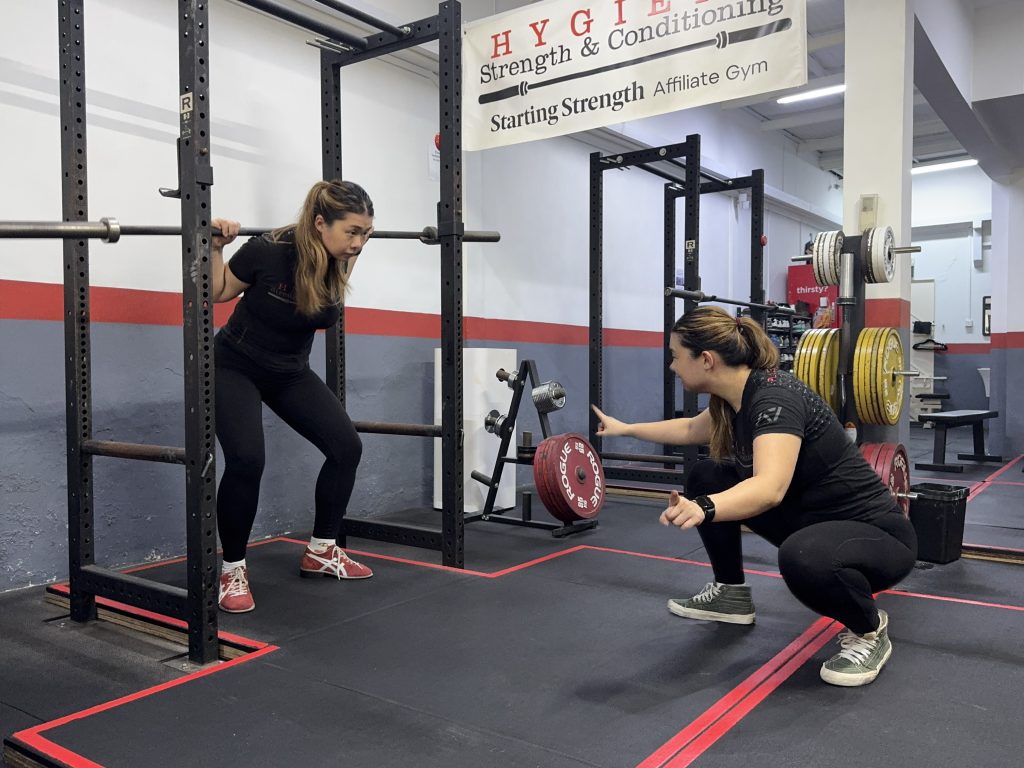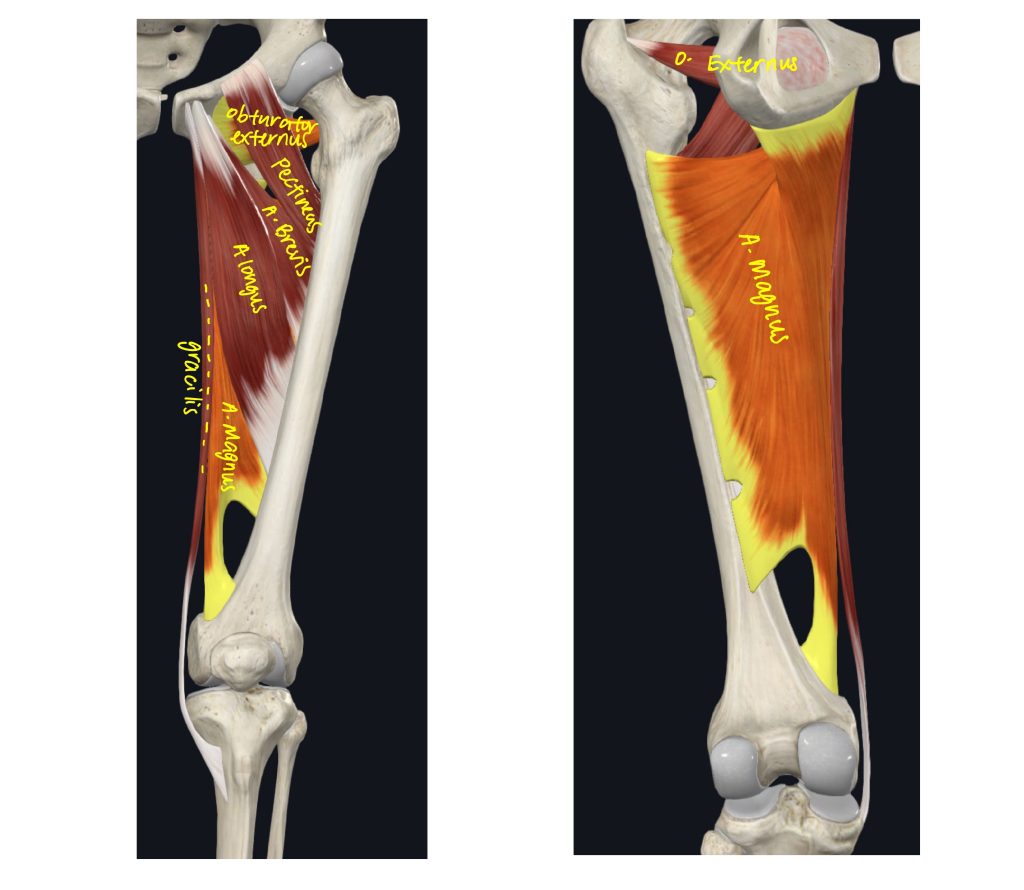
Whenever I’m coaching new lifters who have some prior training experience—either with other trainers or from figuring out barbell lifting on their own—one interesting and common observation they often make is the adjustment to their foot angle in the squat and deadlift, and how their inner thighs feel more “engaged” than they have ever noticed.
A quick internet search—or a glance around most gyms (except Hygieia, of course)—reveals plenty of people squatting and deadlifting with their toes pointed straight ahead and their feet parallel. It’s a natural default for many lifters, after all, the advice readily available online often suggests keeping your feet straight. At face value, that seems logical enough, right? So why do we at Hygieia recommend pointing your toes out instead? While there are several advantages to an angled stance, this article will focus on one in particular: its role in recruiting a commonly overlooked muscle group – The Groin.
The discussion behind the groin’s importance brings us to a key reminder: since our goal is to get as strong as possible, we need to include the most muscle mass and work them across the longest effective range of motion, so that the heaviest weight possible can be lifted. The movement patterns of all the lifts performed will have to engage most, if not all, the possible muscle groups and they have to be put to the greatest amount of effective work.
The adductors, your groin muscles
Most people tend to focus on working their quads, glutes, and back muscles—but don’t forget about what your groin (adductor) muscles are doing too. The adductor group consists of five muscles that can contribute significantly to your squat and deadlift. These muscles attach along the inner thighs, connecting from around the crotch area down to the point where your seat bone sticks out.

Left panel: anterior (frontal) view, of obturator externus, pectineus, adductor brevis, adductor longus, gracilis, and adductor magnus.
Right panel: posterior (rear) view, providing a clearer perspective on the broad attachment of the adductor magnus along the femur, as well as a partial view of the obturator externus.
The largest of them, the Adductor Magnus, spans the widest area between these two bones and represents the group’s biggest contributor. Since Mr. Magnus and his friends can bring quite a lot to the table, we intentionally cue you to point your toes out when squatting and deadlifting—so you can bring the groin into the movements and make full use of that potential.
The groin in the squat
Your stance—heels about shoulder-width apart, with feet turned out at a 30 – 35 degree angle—helps you reach proper squat depth, where your hip crease dips just below the top of your kneecaps. This is the standard we use to define an appropriately deep squat.
As you approach the bottom, your femurs externally rotate as your knees are pushed out, tracking in line with your toes. Remember where the Adductor Magnus attaches? With your knees pushed out, the distance between them and your seat bones increases, which stretches the adductor muscles tighter along the inner thigh, the medial aspect of your femur. This creates tension between your femurs and seat bones due to the eccentric (lengthening) action of the groin muscles – tension that stores potential energy for the upward phase of the squat.
When you drive back up from the bottom, these adductor muscles shorten – like a stretched rubber band snapping back—working alongside the prime movers, like the glutes and quads, to extend your hips and bring you to lockout. Not only do your main muscle groups get stronger, but your adductors also play a smaller yet crucial role in helping with hip extension.
The groin in the deadlift
Before we talk about how the adductors work in the deadlift, here’s a recap on how to deadlift using the five-step setup process:
1. Hip-width stance
2. Grip the bar just outside your shoes
3. Shins to the bar + knees out
4. Raise your chest
5. Pull the bar off the floor
Step three – getting your knees out – sets you up to recruit the groin muscles in a similar way to the squat. This external rotation of the femur creates room for the adductors to lengthen right from the start. As you pull the bar off the floor, those lengthened adductor muscles contract as your legs straighten toward lockout, working as hip extensors and contributing to the lift.
It’s usually easy to remember all five steps on the first rep of a set. But by the third or fourth rep, many lifters start skipping steps due to fatigue and impatience. In the rush to finish five reps, that crucial “knees out” cue tends to get forgotten.
If this sounds familiar, slow down next time you set up. Don’t forget to shove your knees out – just like you would in the squat.
Knees out: other benefits
There are key similarities between the squat and deadlift at their lowest positions: both require you to maintain back extension at a specific depth. Both lifts have a defined hip height – not any higher, not any deeper. They are also pretty challenging positions to maintain under stress and with so much tension from the barbell’s feedback.
When you shove your knees out in both the squat and the deadlift, your thighs angle away from the midline, creating space for your abdomen and gut at the bottom of the squat and in the deadlift setup. This extra space allows the hips to externally rotate and makes it easier to achieve and maintain back extension in both positions.
Every lifter will have their own unique set of angles due to individual body structure—no two people are built exactly the same. While there’s room for minor adjustments in your setup, we generally advise against changing too much, especially if it compromises the foundational reason we train: to get stronger by using as much muscle mass as possible through the longest effective range of motion.
The setup cues we teach are designed to help you do just that. So, in both lifts, make it a habit to shove your knees out so they track in line with your feet. Not only will your groin muscles get stronger, but you’ll also find it easier to reach proper squat depth and set up efficiently for your deadlifts. And if you don’t do it automatically, fret not. Your coaches would hound you about it till the end of time.

